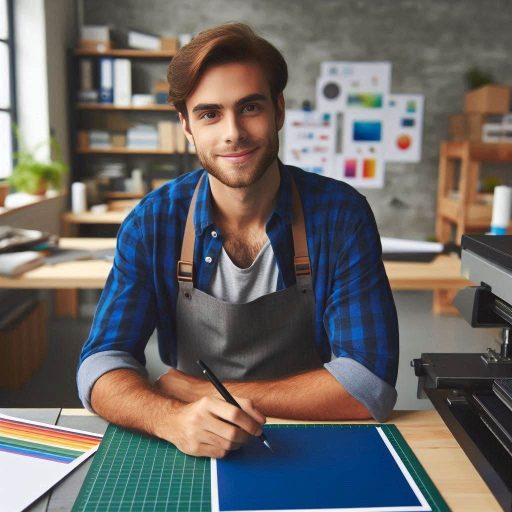Introduction
Printmaking in art therapy offers a unique and impactful way to explore emotions and foster creativity.
Art therapy uses artistic processes to help individuals manage and express their feelings.
Among various artistic methods, printmaking stands out for its tactile, versatile, and expressive qualities.
Printmaking involves creating artworks by transferring ink from a matrix onto a surface.
This matrix could be a carved block, a plate, or a screen.
The process includes techniques like linocut, etching, and screen printing.
Each technique provides a different texture and visual outcome, enriching the therapeutic experience.
In therapy, printmaking encourages self-expression and exploration.
The physical act of creating prints allows individuals to engage with their emotions in a tangible way.
This hands-on process can be particularly effective for those who find verbal communication challenging.
Printmaking also helps build confidence and a sense of accomplishment.
Completing a print project provides a visual representation of one’s creative effort.
This can be incredibly empowering and affirming, boosting self-esteem and providing a sense of achievement.
Additionally, printmaking can improve fine motor skills and focus.
The precise nature of printmaking requires attention to detail and careful handling of materials.
This practice can enhance concentration and hand-eye coordination, contributing to overall cognitive and motor development.
In this post, we will explore these benefits in more detail.
We will discuss how printmaking fosters emotional expression, builds self-confidence, and enhances motor skills.
Understanding these aspects will highlight why printmaking is a valuable tool in art therapy and how it can positively impact therapeutic outcomes.
Therapeutic benefits of printmaking
How printmaking can serve as a form of self-expression and communication for individuals in therapy
Printmaking offers unique therapeutic benefits in art therapy, providing individuals with a valuable means of self-expression and communication.
Transform Your Career Today
Unlock a personalized career strategy that drives real results. Get tailored advice and a roadmap designed just for you.
Start NowFor many in therapy, expressing emotions through traditional verbal methods can be challenging.
Printmaking, however, enables them to convey feelings visually and tangibly.
The process of creating art prints allows individuals to communicate complex thoughts and emotions in a direct and non-verbal manner.
How the process of creating prints can help individuals explore their emotions and thoughts
The printmaking process itself is deeply introspective.
As individuals engage in the creation of prints, they explore their inner landscapes.
The act of choosing colors, textures, and shapes can mirror emotional states and personal experiences.
This exploration helps individuals understand and articulate their feelings.
Through repeated experimentation and reflection, they gain insights into their emotional worlds and discover new ways to process their thoughts.
The tactile and sensory experience of printmaking that can promote relaxation and stress relief
Moreover, printmaking provides a rich tactile and sensory experience.
The texture of the materials, the sensation of pressing the ink, and the transformation of the print can be soothing.
These sensory experiences contribute to relaxation and stress relief.
The hands-on nature of printmaking engages multiple senses, creating a meditative and calming environment.
This sensory engagement helps individuals focus on the present moment, reducing anxiety and promoting overall well-being.
In summary, printmaking in art therapy offers profound therapeutic benefits.
It facilitates self-expression and communication, aids in emotional exploration, and provides a soothing sensory experience.
By integrating printmaking into therapy, individuals can enhance their emotional health and find new pathways to healing.
Read: Skills Needed to Excel in Printmaking
Building self-esteem and confidence
How creating prints can boost self-esteem by providing a sense of accomplishment
Printmaking in art therapy offers profound benefits for building self-esteem and confidence.
Engaging in this creative process provides individuals with a sense of accomplishment.
As they create unique prints, they witness tangible results of their efforts, reinforcing their sense of achievement.
Each completed print stands as a testament to their skill and creativity, boosting their self-worth.
How the creative process in printmaking can empower individuals to experiment and take risks in a safe environment
The creative process of printmaking also empowers individuals to experiment and take risks in a safe environment.
Art therapy encourages exploration, allowing participants to try new techniques and styles without fear of judgment.
This freedom to experiment fosters a sense of adventure and personal growth.
By taking risks and learning from the outcomes, individuals gain confidence in their abilities and judgment.
How positive feedback and validation from art therapists can help individuals build confidence in their artistic abilities
Positive feedback and validation from art therapists further enhance this process.
Art therapists provide constructive comments and encouragement, which are crucial for building confidence.
When individuals receive affirmation for their work, they feel valued and recognized.
This support helps them overcome self-doubt and reinforces their belief in their artistic capabilities.
In summary, printmaking in art therapy helps build self-esteem and confidence by offering a sense of accomplishment, encouraging experimentation, and providing positive reinforcement.
As individuals create and share their prints, they grow in self-assurance and artistic expression.
Additionally, receiving positive feedback and validation from art therapists can be incredibly empowering for individuals participating in printmaking.
Art therapists are trained to provide supportive and encouraging feedback that helps clients recognize their strengths and progress in their artistic journey.
This positive reinforcement can help individuals build confidence in their skills and trust their creative instincts.
Read: Printmaking Techniques: Collagraph Printing

Fostering mindfulness and presence
How the repetitive and meditative nature of printmaking can promote mindfulness
Printmaking is more than an art form; it’s a powerful tool for promoting mindfulness and presence.
The repetitive and meditative nature of printmaking fosters a calming environment, allowing individuals to focus on each step of the process.
The act of transferring ink from plate to paper requires steady, deliberate movements.
This repetition encourages a meditative state, where the mind can quiet down and become more centered.
How focusing on the present moment during printmaking can help individuals reduce feelings of anxiety and worry
Engaging in printmaking helps individuals concentrate on the present moment.
As they press, roll, and print, they immerse themselves in the task at hand.
This focus can distract from everyday worries and reduce feelings of anxiety.
By anchoring their attention to the physical process, individuals can momentarily escape stress and find solace in the rhythmic activity.
The therapeutic value of being fully present and engaged in the creative process
Being fully present in the printmaking process enhances its therapeutic value.
When individuals are engaged in creating art, they enter a state of flow, where time seems to dissolve.
This immersion allows them to experience a profound sense of relaxation and satisfaction.
The simple act of creation becomes a form of self-care, helping them manage stress and nurture their mental well-being.
Printmaking encourages mindfulness by engaging both the mind and body.
The physical actions involved, from inking to pressing, require focused attention.
This engagement fosters a mindful awareness that can extend beyond the studio.
By practicing mindfulness through printmaking, individuals can develop coping strategies to handle anxiety and cultivate a greater sense of peace in their daily lives.
In fact, printmaking’s repetitive and meditative aspects make it a valuable practice for fostering mindfulness.
Focusing on the present moment during printmaking can alleviate anxiety and enhance mental well-being.
The therapeutic benefits of being engaged in the creative process offer profound personal growth and emotional balance.
Read: Tips for Maintaining Your Ceramic Art Studio
Processing trauma and emotions
How printmaking can be used to process and express complex emotions related to trauma
Printmaking offers a powerful method for processing and expressing complex emotions related to trauma.
This art form provides a tangible way to confront and articulate difficult experiences.
The cathartic nature of printmaking in allowing individuals to release pent-up emotions
When individuals face trauma, emotions can become overwhelming and hard to express.
Printmaking enables them to externalize these feelings creatively.
Each print serves as a visual representation of what might be too painful or abstract to communicate with words.
How creating prints can serve as a nonverbal outlet for individuals to work through their feelings
The cathartic nature of printmaking is significant.
Engaging in the process allows individuals to release pent-up emotions.
The act of creating—whether through carving, inking, or pressing—can be deeply therapeutic.
This physical involvement helps transform inner turmoil into a visible, manageable form.
Printmaking is also a nonverbal outlet for working through feelings.
For those who struggle with verbal expression, creating prints can be an effective alternative.
The process involves decisions about design, texture, and color, offering a way to channel and understand emotions without words.
Moreover, the repetitive and methodical nature of printmaking can be soothing.
Each step, from planning to execution, provides a structured environment for emotional exploration.
This structured approach helps individuals gain clarity and process their experiences.
All in all, printmaking supports emotional processing by allowing individuals to visually and physically engage with their trauma.
It provides a cathartic release of pent-up emotions and serves as a nonverbal means of exploring complex feelings.
This art form not only facilitates expression but also fosters healing and understanding in a safe, creative space.
Read: How to Frame and Preserve Printmaking Art
Enhancing social connections
How printmaking in group therapy settings can foster a sense of community and belonging
Printmaking in group therapy settings offers unique opportunities to foster community and belonging.
Engaging in printmaking together allows participants to share a creative space and build connections.
Each printmaking session becomes a collaborative effort, enhancing interpersonal relationships and group cohesion.
The tactile nature of printmaking invites conversation and shared experiences, making it easier for individuals to connect on a personal level.
How collaborative printmaking projects can encourage teamwork and communication among participants
Collaborative printmaking projects are particularly effective in encouraging teamwork and communication.
Participants work together to create prints, requiring them to discuss ideas, plan actions, and make decisions collectively.
This shared process builds trust and strengthens relationships.
As participants engage in dialogue about their creative choices, they develop better communication skills and learn to appreciate diverse perspectives.
Such projects break down social barriers and foster a sense of unity among group members.
The role of art-making in bridging social barriers and promoting shared experiences
Art-making plays a crucial role in bridging social barriers and promoting shared experiences.
When participants engage in printmaking, they focus on the process rather than their differences.
This focus helps them connect through a common activity and shared goals.
Printmaking allows individuals from diverse backgrounds to collaborate, creating a collective work of art that reflects their combined efforts.
The result is a tangible representation of their shared journey and mutual understanding.
In essence, printmaking in group therapy settings enhances social connections by fostering a sense of community, encouraging teamwork, and bridging social barriers.
The collaborative nature of printmaking helps individuals communicate better, work together more effectively, and build meaningful relationships.
By focusing on the creative process, participants overcome differences and create shared experiences that strengthen their social bonds.
Increasing self-awareness and insight
How the reflective nature of printmaking can help individuals gain insights into their thoughts and behaviors
Printmaking in art therapy offers a unique path to self-discovery and personal growth.
Its reflective nature plays a crucial role in helping individuals gain insights into their thoughts and behaviors.
As individuals engage in printmaking, they often find themselves exploring emotions and experiences that might be difficult to express verbally.
This process of creating prints encourages introspection, allowing individuals to confront and understand their inner worlds.
How creating visual representations through prints can offer new perspectives on personal experiences
Creating visual representations through prints can provide fresh perspectives on personal experiences.
The act of translating thoughts and feelings into visual forms allows individuals to view their experiences from a different angle.
Each print becomes a mirror reflecting aspects of their psyche, offering clarity and new understandings.
This visual approach can reveal patterns and themes that might not be apparent through traditional verbal therapy alone.
The role of art therapists in facilitating self-exploration and guiding individuals towards self-awareness
Art therapists play a pivotal role in facilitating this journey towards self-awareness.
They guide individuals through the printmaking process, helping them to explore and articulate their emotions.
Therapists support clients in interpreting their prints, encouraging them to reflect on what these visual representations reveal about their inner selves.
Through this guidance, individuals gain deeper insights into their personal experiences and develop a greater understanding of themselves.
By integrating printmaking into art therapy, individuals not only create tangible works of art but also embark on a journey of self-discovery.
This process fosters self-awareness, offering new ways to understand and engage with one’s thoughts and feelings.
The reflective and interpretive nature of printmaking, combined with the therapist’s support, enhances personal insight and promotes emotional growth.
Conclusion
Printmaking offers numerous benefits in art therapy.
It provides a unique avenue for self-expression.
Printmaking can help individuals tap into their emotions and facilitate healing through creative processes.
It encourages exploration and experimentation.
The tactile nature of printmaking allows for sensory engagement, leading to a deeper connection with the artwork created.
By incorporating printmaking in art therapy, practitioners can promote emotional well-being and offer clients a therapeutic outlet.
Individuals who engage in printmaking may experience a sense of accomplishment and improved self-esteem through artistic expression.
Overall, printmaking serves as a powerful tool in art therapy, promoting self-discovery, healing, and personal growth.
It is essential for both professionals and individuals to consider incorporating printmaking into their practice or personal life.
Through printmaking, individuals can explore their emotions, express themselves creatively, and find solace in the therapeutic process.
By utilizing printmaking as a form of art therapy, individuals can unlock new paths to self-discovery and emotional well-being.
Incorporating printmaking into art therapy can be a transformative experience, offering a unique medium for healing and self-expression.




